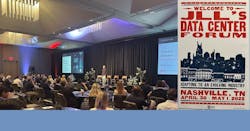Land, Liquidity, and AI: JLL Forum Charts the Data Center Investment Horizon
As data center investment surges past previous highs, the conversations at the 2025 JLL Data Center Forum—held May 1 in Nashville under Chatham House Rule—revealed a sharpened focus on power, capital, and the human talent required to manage both.
Hosted by real estate giant JLL, the forum brought together leaders from across infrastructure finance, hyperscale deployment, and critical facilities management. What emerged was a picture of an industry entering a more complex phase of growth: one defined as much by cautious optimism and procurement pressure as by opportunity and innovation.
A Year After SKAE: JLL Doubles Down on Data Centers
The event marked a milestone: one year since JLL’s acquisition of SKAE Power Solutions, a deal that bolstered JLL’s in-house technical bench at a time when demand for critical facility expertise has never been higher. The SKAE integration represents more than just workforce absorption—it’s a commitment to full-lifecycle service delivery at a time when hyperscale AI requirements are rewriting the rulebook for data center development.
“The mantra is talent, talent, talent,” one speaker emphasized, reflecting an industry-wide refrain that goes beyond electrical engineers and leasing pros to include specialists in permitting, environmental compliance, and AI-specific workload design. With AI infrastructure demand layering atop cloud demand, the sector's workforce expectations are accelerating even further.
A Dynamic Industry Confronts Structural Limits
“What does this room look like in 2035?” asked one keynote speaker, posing a ten-year challenge to a room of power brokers. The consensus: data centers remain at the heart of global digital transformation, but maintaining the current growth trajectory will require a recalibration of assumptions around capital availability, utility timelines, and risk modeling.
Panelists cited JLL’s Global Data Center Outlook, which forecasts global storage demand to more than double by 2027—from 10.1 ZB in 2023 to 21.0 ZB—fueled by data from AI training, edge devices, and enterprise transformation. But building the physical infrastructure to support that data has gotten harder, not easier.
“The industry is so dynamic and growing so fast, yet there are few industries that can grow so fast for so long,” said one participant. The forum’s first session, “Capital Markets: The Money Behind the Megawatts,” drove home the reality: the AI era is pushing everyone—from REITs to sovereign wealth funds—to rethink the data center investment model.
Risk as Incentive: Capital’s New Calculus
2024 was a record-setting year for new construction, fueled by generative AI demand and hyperscaler pipeline expansion. But entering 2025, capital markets are contending with ripple effects from U.S. trade policy, global economic jitters, and mixed signals from cloud providers.
Panelists from Affinius Capital, Compass Datacenters, Green Street, and JLL acknowledged that headlines about DeepSeek’s capacity shift and AWS and Microsoft’s procurement recalibrations had raised investor eyebrows. Yet, despite some “hyperscale noise,” the fundamentals remain solid. As recent earnings reports have shown, hyperscalers are still growing—and growing profitably.
The challenge? Underwriting has become a more cautious endeavor. “You almost need to create a more speculative capital bucket to even pursue a site,” one panelist said, noting the sheer complexity of securing power contracts, entitlements, and water rights.
Green Street analysts observed that transaction trends remain biased toward real estate plays rather than full turnkey solutions—indicating a still-fragmented delivery model and a preference for asset-light approaches among some capital sources.
Still, optimism held. “Despite the volatility, there are ample liquidity options from a reference perspective,” said one panelist, pointing to debt markets, asset-backed securities (ABS), and rising interest from sovereign wealth capital, particularly from Australia and the UAE.
Powered Land, Spec Shells, and the AI Tectonic Shift
Panelists agreed on a major trend reshaping North American strategy: the rise of land banking and speculative powered shells. With power lead times often exceeding three years, developers are increasingly deploying capital into land loans and substation construction ahead of lease commitments.
The goal is twofold: control the timeline and capture long-term tenant interest, especially from inference-heavy AI workloads. “AI inference is starting to pop up in a pretty significant way,” said one speaker, pointing to JLL’s recent deals where inference, not training, was the primary driver of capacity demand.
In this environment, JLL is positioning itself not just as a broker or developer, but as a “premium strategic focus” partner in land value realization—navigating capital, regulatory hurdles, and infrastructure planning.
Tariffs, Rates, and the Cost of Capital
The U.S. administration’s recent tariff moves on Chinese components injected fresh uncertainty into project costs. While most panelists agreed the supply chain has adapted since COVID, general contractors are reporting 5% cost increases and pressure on delivery timelines.
“Is this going to cause a pause in spending?” the panel asked itself rhetorically. The answer: probably not. Not when REITs with data center portfolios are still outperforming all other asset classes, up more than 3% since “Liberation Day,” and not when hyperscalers continue to commit to 15-year build-to-suit leases.
The conversation turned to the fundamentals of pricing. In wide-open primary markets such as Phoenix as well as in key secondary and tertiary markets, land and power availability are making it easier to de-risk. “Tenants are committed, and there’s an opportunity to recycle capital,” one panelist noted. But underwriting remains deal-specific, with build-to-suit and powered shells each requiring different capital stack strategies.
Are customers trying to back into a per-kW rate? Yes—but open-book contracts and transparent build models are making it easier to balance cost and margin, especially for partners willing to be flexible on delivery.
Looking Ahead: 2025 as a Test Year
What does the rest of 2025 hold? The panel predicted a possible uptick in transaction activity despite macro risk. “Risk has increased incentive,” one expert observed, suggesting that volatility itself is prompting faster decision-making and capital deployment.
With AI workloads proliferating and infrastructure constraints still tightening, 2025 could become a year of experimentation: in financial models, procurement strategies, and data center designs tailored to new demand curves.
What’s clear is this: the data center sector has moved beyond linear growth. It now occupies a strategic intersection of power, capital, and talent. And players like JLL are recalibrating their role to shape what comes next.
JLL's Andrew Batson analyzes 2025 data center construction projections, financing and investment trends. At this year's third annual JLL Data Center Forum, attendees learned how this asset class compares to others, and how investors tackle obsolescence concerns.
At Data Center Frontier, we talk the industry talk and walk the industry walk. In that spirit, DCF Staff members may occasionally use AI tools to assist with content. Elements of this article were created with help from OpenAI's GPT4.
Keep pace with the fast-moving world of data centers and cloud computing by connecting with Data Center Frontier on LinkedIn, following us on X/Twitter and Facebook, as well as on BlueSky, and signing up for our weekly newsletters using the form below.
About the Author
Matt Vincent
A B2B technology journalist and editor with more than two decades of experience, Matt Vincent is Editor in Chief of Data Center Frontier.



